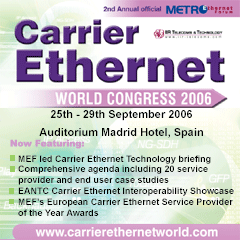|
|

article page | 1 | 2 | 3
The Trouble with IP
Peer-to-peer (P2P) file-sharing, Internet telephony, pay-per-view, on-line gaming and other high bandwidth applications are taking over the Internet. The proliferation and adoption of these applications is astounding and offers an opportunity for service providers to broaden their service offerings and create new streams of revenue. But, as more applications and users traverse the networks, service levels decline.
As it stands, IP is a fairly primitive vehicle. In and of itself, IP is not application-aware, nor is it subscriber-aware. It can deliver simple usage statistics, but it does not have any built-in priority mechanisms and it cannot solve contention issues. In our airport analogy, IP is the runway.
When a finite resource, shared among a growing population with more robust traffic, has minimum QoS standards, the solution is always “segmentation” and “optimization” of the resource to better meet demand. But, IP alone cannot offer any segmentation or optimization capabilities. So, providers either do without and hope for the best, or they deploy DPI for service optimization.
|
|


For example, it is not uncommon for P2P traffic to consume up to 70 percent of total capacity for some providers. With DPI for service optimization, the provider can create a simple traffic policy (with a few mouse clicks) that immediately limits P2P traffic to 20 percent, thereby instantly freeing up 50 percent of total Internet bandwidth. Different policies can be set for downstream (to the subscriber) vs. upstream (away from the subscriber) traffic flows.
|
|
|
|
|

Using technology to enforce business service levels
Capable of accurately identifying hundreds of applications, DPI for service optimization can detect changes in levels of users, monitor network status, evaluate trends and track network behavior down to a single connection. This is equivalent to the traffic control systems at airports. While most IT administrators don’t have an airspace map with blinking dots on it, the concept is parallel.
With automated policy-enforcement capabilities inherent within DPI, businesses can set minimum levels of service quality for the business and then create network performance policies to ensure that business policies are met.
|
|

Usage statistics are collected on a continuous basis, offering real-time visibility into all aspects of the network. This helps IT administrators understand the past and the present, as well as make intelligent forecasts on future behaviors to pre-empt potential network issues. The network also can report on abnormal phenomena as it happens, allowing administrators to make real-time changes to maintain service levels even in crisis mode.
Once visibility into usages, habits and behaviour is in place, IT administrators can use this wealth of detailed utilization data to intelligently evaluate and segment individual users into homogenous groups such as gamers, VoIP users, high-bandwidth users, casual users or others. Categorizing users into groups and understanding their usage
|
|
|
|




